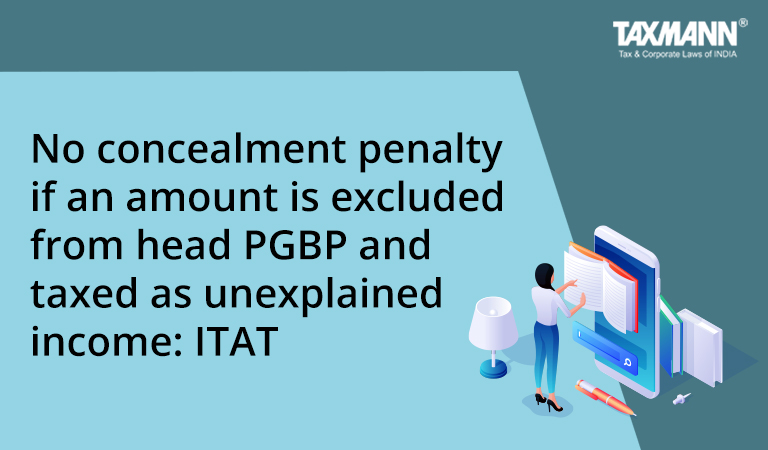No concealment penalty if an amount is excluded from head PGBP and taxed as unexplained income: ITAT
- Blog|News|Income Tax|
- 2 Min Read
- By Taxmann
- |
- Last Updated on 1 November, 2021
Case Details: Deepak Wadhwa v. ACIT, - [2021] 131 taxmann.com 205 (Delhi - Trib.)
Judiciary and Counsel Details
-
- H.S. Sidhu, Judicial Member and Anadee Nath Misshra, Accountant Member
- Rajesh Mahna and Mayank Kauth, Advs. for the Appellant.
- Rajesh Kumar, Sr. DR for the Respondent.
Facts of the Case
Assessee filed return of income on 15-10-2010 declaring income of Rs. 59.67 lakhs. The returned income was accepted by revenue, and the same was not selected for scrutiny. However, subsequently, proceedings under section 147 were started by issue of notice under section 148.
Assessee once again filed a copy of the earlier return file on 15-10-2010 and showed a returned income of Rs. 59.67 lakhs. In the assessment order passed by Assessing Officer, an amount of Rs. 6.62 lakhs was excluded from head ‘profits and gains of business and profession’ (PGBP) and was added under section 68.
Assessing Officer levied penalty under section 271(1)(c), holding that assessee had furnished inaccurate particulars of income. On appeal, the CIT(A) confirmed the order of AO. Aggrieved-assessee filed the instant appeal before the Tribunal.
ITAT Held
The Delhi Tribunal held that the effect of the Assessment Order was that the head under which an amount of Rs. 6.62 lakhs was assessed, changed from income under “PGBP” to addition under section 68. However, the overall assessed income of the assessee was the same as shown in the original return.The AO as well as the Ld. CIT(A) had failed to make out a case for levy of concealment penalty. They had been unable to show how the allegation of furnishing of inaccurate particulars of income could be said to have resulted in tax sought to be evaded by the assessee when assessed income was the same as returned income.
The allegation that the assessee had the bogus income or bogus credit was pointless because the corresponding amount was already included in the returned income of the assessee. There must be some tax sought to be evaded by the assessee to impose penalty u/s 271(1)(c).
Case Review
-
- CIT v. Indian Metals & Ferro Alloys Ltd. [1995] 211 ITR 35 (Orissa) (para D)
- CIT v. Drapco Electric Corpn. [1980] 122 ITR 341 (Guj.) (para D)
- CIT v. Zoom Communication (P.) Ltd. [2010] 191 Taxman 179/327 ITR 510 (Delhi) (para D) distinguished.
List of Cases Referred to
-
- CIT v. Indian Metals & Ferro Alloys Ltd. [1995] 211 ITR 35 (Orissa) (para D)
- CIT v. Drapco Electric Corpn. [1980] 122 ITR 341 (Guj.) (para D)
- CIT v. Zoom Communication (P.) Ltd. [2010] 191 Taxman 179/327 ITR 510 (Delhi) (para D) distinguished.
Disclaimer: The content/information published on the website is only for general information of the user and shall not be construed as legal advice. While the Taxmann has exercised reasonable efforts to ensure the veracity of information/content published, Taxmann shall be under no liability in any manner whatsoever for incorrect information, if any.

Taxmann Publications has a dedicated in-house Research & Editorial Team. This team consists of a team of Chartered Accountants, Company Secretaries, and Lawyers. This team works under the guidance and supervision of editor-in-chief Mr Rakesh Bhargava.
The Research and Editorial Team is responsible for developing reliable and accurate content for the readers. The team follows the six-sigma approach to achieve the benchmark of zero error in its publications and research platforms. The team ensures that the following publication guidelines are thoroughly followed while developing the content:
- The statutory material is obtained only from the authorized and reliable sources
- All the latest developments in the judicial and legislative fields are covered
- Prepare the analytical write-ups on current, controversial, and important issues to help the readers to understand the concept and its implications
- Every content published by Taxmann is complete, accurate and lucid
- All evidence-based statements are supported with proper reference to Section, Circular No., Notification No. or citations
- The golden rules of grammar, style and consistency are thoroughly followed
- Font and size that’s easy to read and remain consistent across all imprint and digital publications are applied








 CA | CS | CMA
CA | CS | CMA


